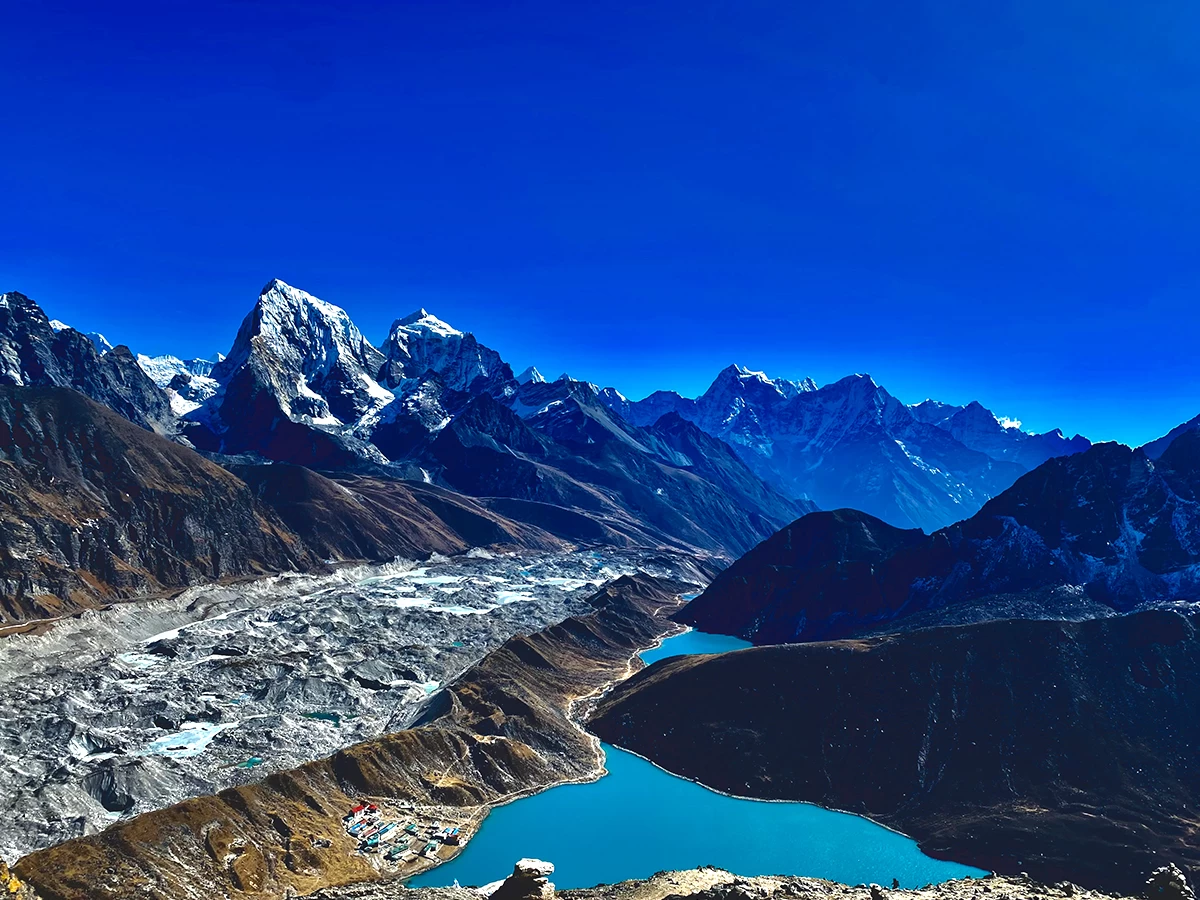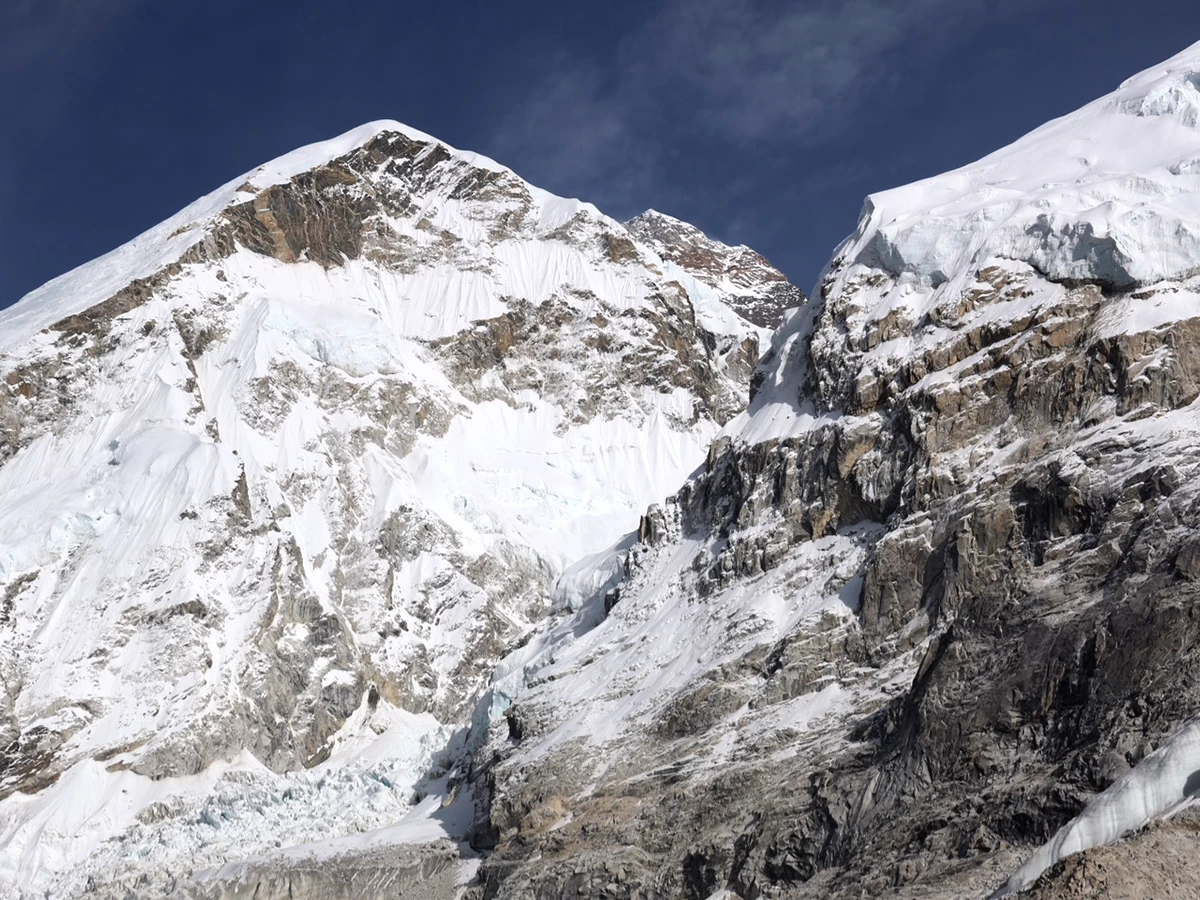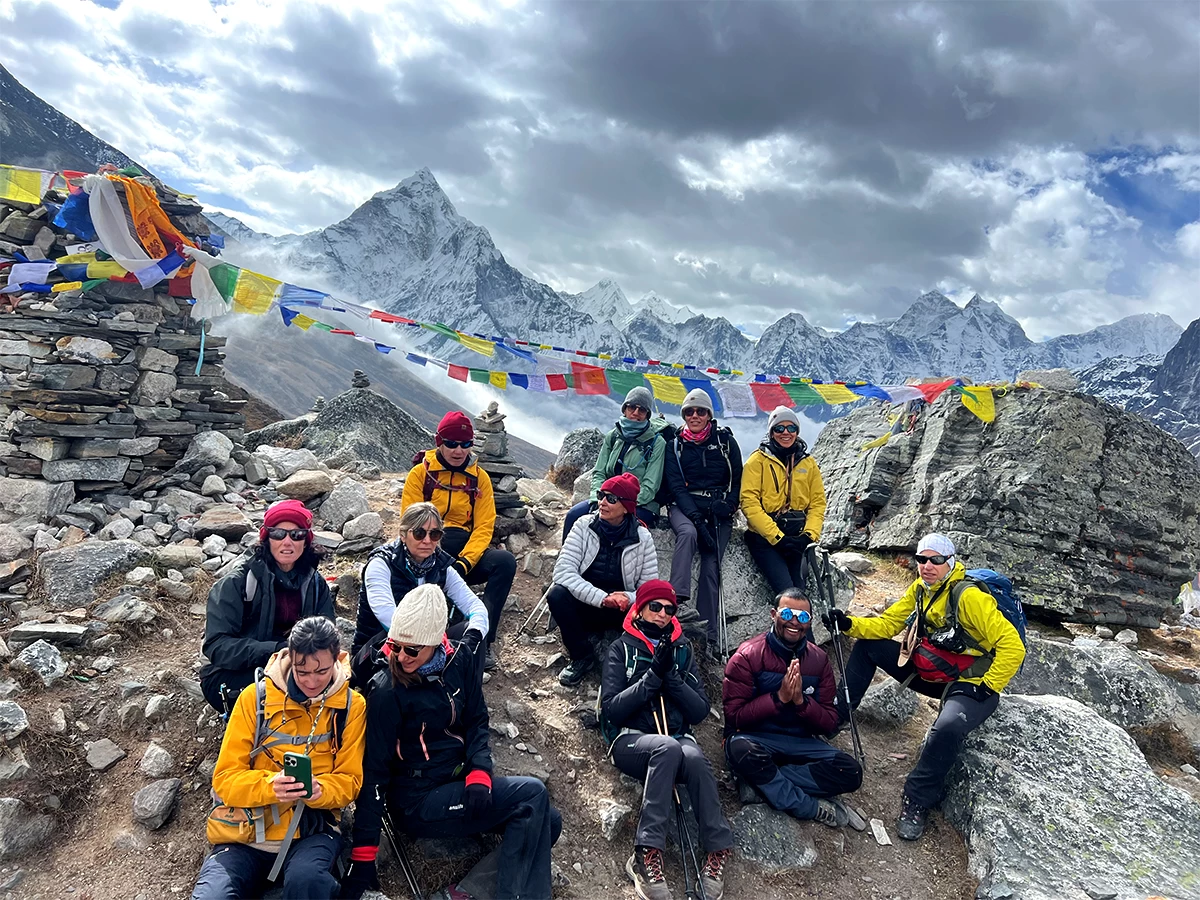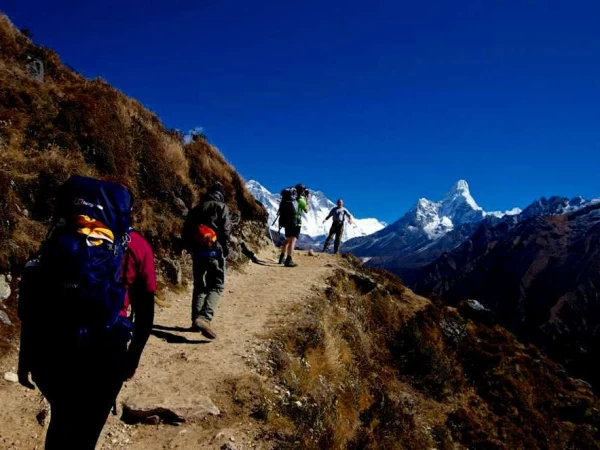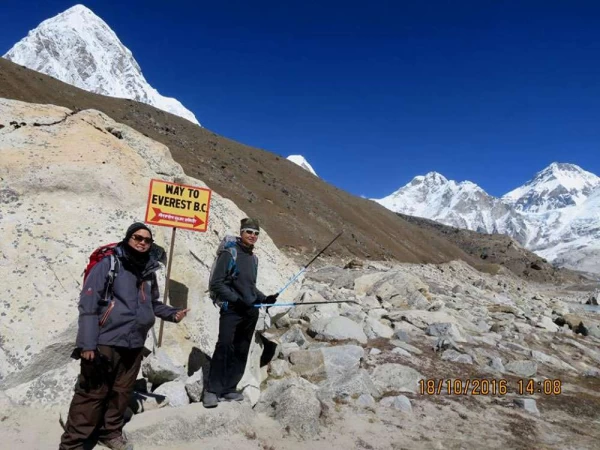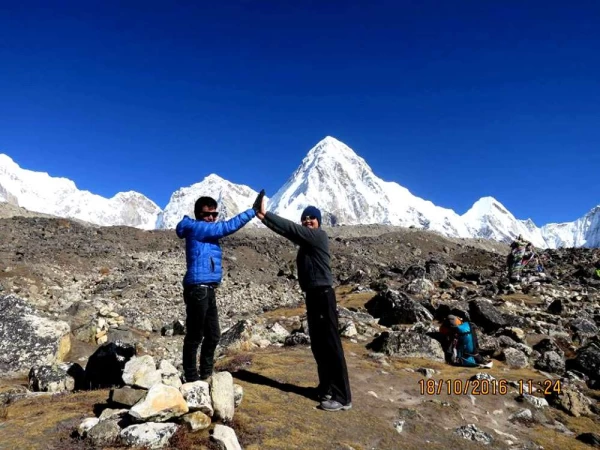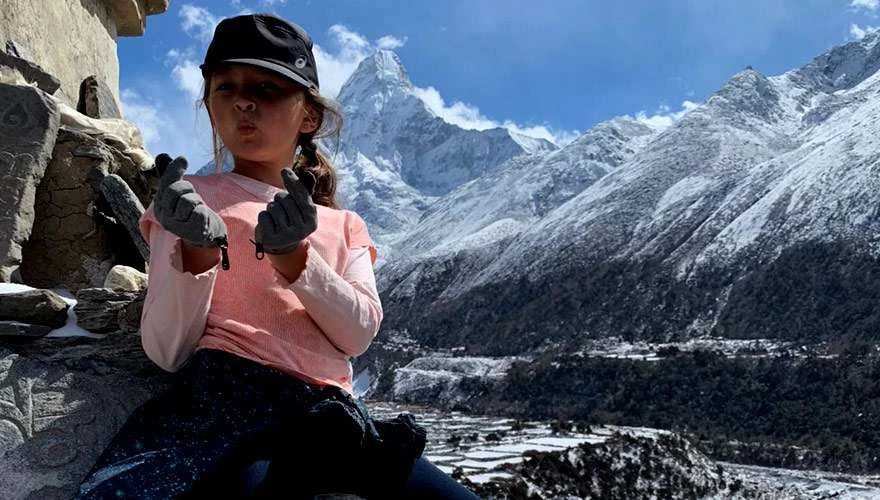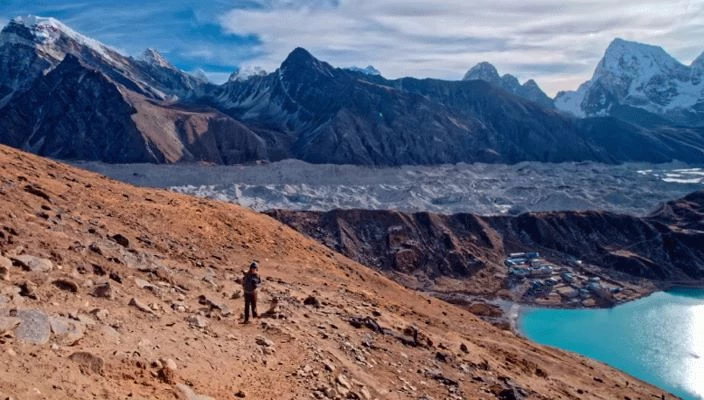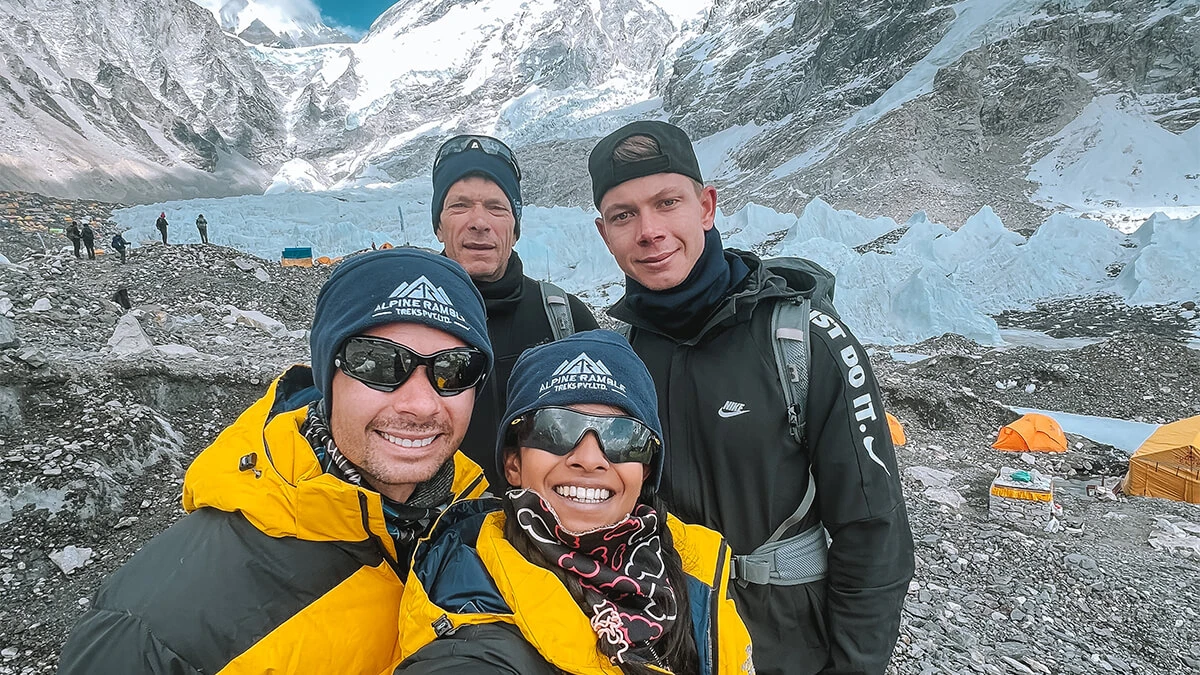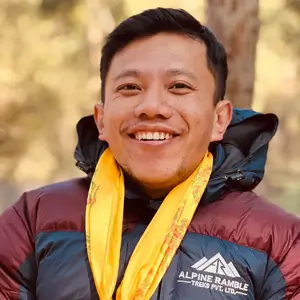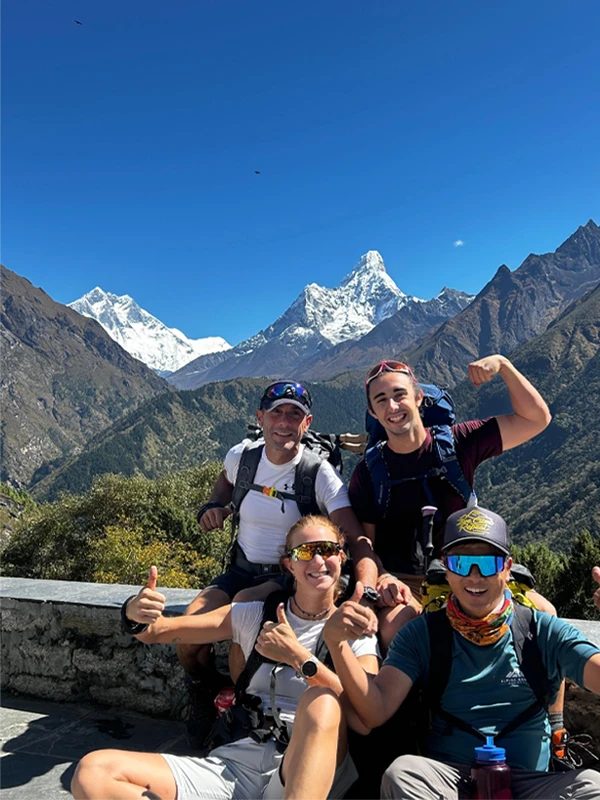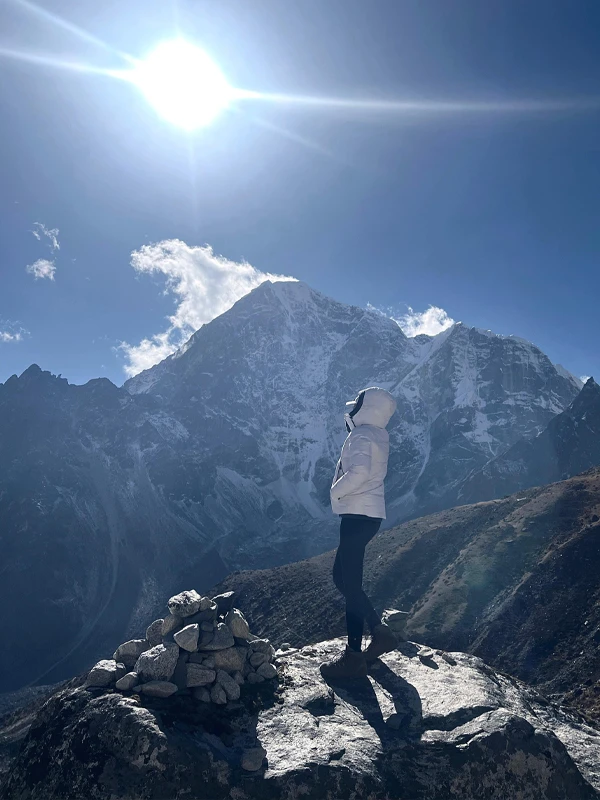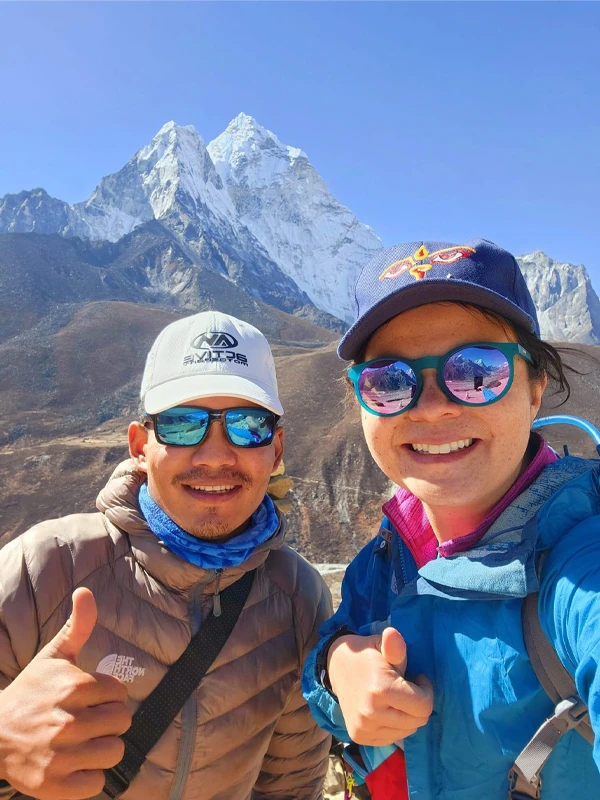Gokyo Lakes Trek is a perfect trekking destination that takes you into the heart of the towering mountains and pristine lakes.
Highlights
- An exhilarating flight to Tenzing Hillary Airport, Lukla.
- An out-of-the-ordinary experience at Namche Bazaar.
- Hike to the world’s highest hotel, Hotel Everest View.
- Excursion to the small hamlet of Khumjung.
- Sightseeing of the Syangboche Airport at an elevation of 3,780 meters.
- Immersing in the warm hospitality of Gokyo village.
- Get lost in the serenity of the pristine Gokyo Lakes.
- Embark on an expedition to the Gokyo Ri.
- Dive into the incomparable Sherpa culture and traditions.
The scenic trail and heavenly sight are filled with alluring snow-capped peaks, engaging Sherpa culture, unique Buddhist traditions, and a captivating natural environment.
In a span of 10 days, you will hike through verdant uphill and downhill trails that will give you some of the most beautiful memories that will last a lifetime.
It is the most popular trekking trail next to the Everest Base Camp and offers a quiet and less busy trail compared to the other commercial routes of the base camp. Your trek begins with a flight to Lukla.
The flight to Lukla comes with aerial views of the mountains that, in a matter of days, will be right in front of your eyes. Once the plane lands at Tenzing Hillary Airport, after probably one of the most thrilling flights of your life, your trek to Gokyo Lakes will officially begin.
At every step of your journey to Phakding, the forests of alpine trees, full of rhododendrons, are shadowed, accompanied by the cascading river of Dudh Koshi. Leading you through some of the most beautiful Sherpa settlements, the stony pavement is sure to be one of the major highlights of the trek.
Suspension bridges cross to bring you to the quaint village of Phakding. The next day, you will continue the hike to the destination of Namche Bazaar. Namche Bazaar is quite a noted village in the Everest region.
As the gateway to Everest, the village has immense value for trekkers as well as climbers. You'll be going through the famous "Hillary Bridge" and then finally entering the Sagarmatha National Park, listed as a UNESCO World Heritage Site.
You will spend two nights in Namche Bazaar as part of acclimatization, during which time you'll get to visit the Hotel Everest View and Khumjung Village.
On the way to Hotel Everest View and the village of Khumjung, the hike becomes refreshing with the sight of gigantic, fairly beautiful mountains at sight, including Ama Dablam, Kangtega, Thamserku, Lhotse, Nuptse, and the tallest mountain in the world, Mount Everest.
The time will also be given to soak in the culture and traditions of the Sherpas, along with Buddhist culture, as you get deeper into the prospects for Khumjung village. Fourth-day treks take one to even higher altitudes, marching on the trails that lead to a rusty village called Dole.
This is the day when we leave behind the commercial route of the Everest Base Camp trek and catch a different route that will direct us to our ultimate goal: the Gokyo Lakes.
Further down the line, during this trek, you will realize some changing landscapes whereby the lush green alpine forests start to disappear and leave a desert kind of geography with short bushes.
And again, you will not miss that captivating view of snow-covered mountains throughout the whole of your hike. The next day, we will climb another tiny but peaceful village, Machhermo. You will actually feel the thin air as you ascend higher up.
But you will be rewarded with a magnificent view of Mt. Cho Oyu when you reach the village where you will spend your night. This is comparatively an easier hike; hence, you'll have more time wandering around the surroundings of the village.
On the sixth day of the trek, you will finally set foot in the Gokyo region. Trekking through today’s route will steer you past some secluded Sherpa villages and mystical Chortens and Stupas.
The steep climb finally rewards us with the oligotrophic lakes of Gokyo. The Gokyo and its associated lakes, which cover a land area of 7,770 ha (30.0 sq mi), were declared Ramsar sites in 2007.
The lakes of Gokyo not only hold importance in a hydrological sense but are also an equally important part of the Sherpa culture and traditions, along with their links to Buddhism and Hinduism.
The next day, we will summit Gokyo Ri (5483 m) for sunrise, which will be an experience in itself as you live in the golden hour when the rays of the sun hit the snow-dusted mountains. Then, we will descend down to Machhermo, where we will rest for the night.
Now that we have experienced the beautiful adventure of the Gokyo Lakes and Gokyo Ri, we will begin descending down the same way we ascended. From Machhermo, we hike the downhill trail and arrive at Namche Bazaar.
After long days of trekking, you are sure to be tired, which is why you can indulge yourself at Namche Bazaar with a spa treatment, eat baked goods at the bakery, or grab a drink at the Irish Pub.
The last day of your trek involves long hours of trekking, where we will again retrace our steps all the way back to Lukla. Then, on the last day of the trek, you will catch an early morning flight back to Kathmandu, where our staff will be waiting to pick you up and transfer you to your hotel.
What makes the Gokyo Lakes Trek a unique adventure in 2024/2025?
Namche Bazaar
Namche Bazaar, of course, is the universal experience for anyone trekking in the Everest region. Not only does it hold great significance for the trekkers and climbers who are ready to take on the mountains, but it also holds historical and cultural significance as it used to be the transit hub for the Sherpas to go to Tibet.
Surrounded by hills and mountains and rich in natural resources, the village is also trendy for its amenities. A hub for trekkers where you can interact with people from all over the world, some of whom share the same destination as you.
Hotel Everest View and Khumjung Village
A trip you should not miss is the trek to the Hotel Everest View to witness the panoramic view of Mount Everest and other equally majestic mountains.
Known for being the hotel at the highest altitude in the world at 3880 meters, the hotel has always been one of the major destinations among trekkers, as it also plays a vital role in acclimation.
The village of Khumjung is another Sherpa settlement rich in culture and nature. The rustic village is full of a mystical aura as it is filled with Buddhist mantras and prayers enchanting in the monastery, which houses the supposed scalp of the Yeti.
Sparkling and Crystal-Clear Gokyo Lakes
Also considered to be the world’s highest freshwater lake system, Gokyo Lakes is one of the best highlights of the entire trek. The freshwater lakes of Gokyo are the heart of Everest's river systems, whose main sources are the Ngozumpa Glacier and the mountains surrounding Gokyo Lakes.
Nonetheless, the six lakes are significant and comprise the main lake, Gokyo Cho, which is also known as Dudh Pokhari and is 42.9 ha (106 acres) in size, and the village of Gokyo is located on its eastern shore. At 65.07 ha (160.8 acres), Thonak Cho is the largest lake. Gyazumpa Cho is 29 ha (72 acres) in size, Tanjung Cho is 16.95 ha (41.9 acres), and Ngozumba Cho is 14.39 ha (35.6 acres) in size.
These lakes are the lifeline for the forests and rivers that are growing and glowing in the lower part of Gokyo. It gives you the perspective to appreciate how nature and cultures interconnect and help each other survive.
A Quiet And Less Crowded Trail of Gokyo
Unlike the popular trail of the Everest Base Camp, which tends to be crowded with trekkers during the peak seasons, the Gokyo Lakes Trek is a refreshing alternative.
Not known and most likely not the first option for many, the trek to the Gokyo Lakes is a true hidden gem of the Everest. Here, you can enjoy the trek by walking on a peaceful trail and enjoying the tranquility of the mountains.
The reflective lakes of Gokyo will take you into its own world of spiritual odyssey, an irreplaceable experience on its own, even compared to the trek to the base camp.
When are the flights to Lukla available for the Gokyo Lakes Trek 2024–2025?
Well, all of that depends on the month and season one is going to travel in. Suppose you want a direct line from Kathmandu to Lukla; it might be dicey. The flight only runs during off-season months—in those winter and summer portions, including December, January, and February, which cover winter, and June, July, and August as summer.
During the peak seasons of spring and autumn, the flight will be directed from Manthali to Ramechhap. Due to high air traffic, all flights to and from Lukla are diverted to Manthali.
The Ramechhap airport is about a 4-hour drive from Kathmandu, where you will be escorted in a public bus or a private car for an additional price.
Is the Gokyo Lake Trek difficult?
You can regard the Gokyo trek as moderate to demanding. If this is your first trek, you might feel that it is pretty challenging and difficult for you, both physically and mentally.
It includes walking for an average of 5–6 hours. The uphill trails and altitude gains are even more challenging, with sustaining a good pace getting hectic.
Do not get disheartened, as with proper preparation, training, and guidance, one can easily hike this very smoothly. Proper hydration and diet throughout the days of trekking, together with good acclimatization, would alternately be the keys to success in their treks.
Of course, your mental strength has a big role to play here. A balance between physical and mental health, therefore, becomes extremely important before stretching oneself up for any challenge.
What type of training should I do for the Gokyo Lakes Trek?
Preparation for the trek should begin at least a month prior to your chosen date. You need to focus on exercise that works out and helps enhance the cardiovascular system of your body.
You should train with uphill hikes whenever possible.
Some tourists even do other easier treks before going to Everest so they can prepare their bodies. But it is not mandatory; you can simply prepare with good exercise and keep your body fit and healthy.
What is the best time for the Gokyo Lake Trek?
Very clearly, Nepal has two seasons that would be considered the best for trekking: spring, which includes the months of March, April, and May, and autumn or fall, which includes the months of September, October, and November.
However, this doesn't mean that summer and winter are not the best times of the year or seasons for trekking. Every season has its own specialties that offer very good reasons for trekking. Many people prefer spring or autumn, as there are high chances of good weather and neither too hot nor too cold is a very comfortable temperature.
The summer season is best if you want to join the greenery of the forests and grasslands. This will also be a period of heavy rain since it is a monsoon; therefore, it somewhat presents a problem during travel, especially due to landslides and floods.
Also, if it is the winter season, you get an excellent view of the mountains with a totally blue sky. The drawback is that it will be extremely cold during the winter, and walking on snow is quite a task. You need to mentally prepare for temperatures like -20 degrees Celsius.
The Gokyo Lakes Trek: Guide Cost, Porter Cost, Flight Cost, and Permit Cost Information
Vehicle Cost from Kathmandu to Manthali for the Gokyo Lakes Trek
Local Bus: $15 (Included in Package)
Private Jeep (one-way): $150 / Jeep (ADD-ON)
Flight Cost to Lukla for the Gokyo Lakes Trek
Kathmandu to Lukla: $216
Manthali to Lukla: $180
Cost of Helicopter ride to Lukla (One Way, Sharing) (ADD-ON)
Kathmandu to Lukla: $500–$700
Manthali to Lukla: $400-$500
Gokyo to Lukla: $1700
Gokyo to Kathmandu: $5000
TIMS Card and Permit Cost for the Gokyo Lakes Trek
It is imperative that you obtain permits before trekking. It is necessary for your safety and security that, apart from a TIMS card, you will need the following permits before your trek to Gokyo:
Trekker’s Information Management System (TIMS): $20
Pasang Lhamu Municipality Fee: $20
Sagarmatha National Park Fee: $30
Guide and Porter Cost for the Gokyo Lakes Trek for 2024-2025
Both trekking guides and porters have their own charging value set by the government of Nepal. The standard cost for a trekking guide is 35 USD per day, whereas the standard set cost for hiring a porter is 25 USD per day.
Once you purchase our trekking package, the cost of the trekking guide is already included in the package, but the cost of hiring a porter is to be paid separately upon hiring.
That means you have the option to choose if you want to hire a porter or not, but taking a guide during your trek is absolutely mandatory as per the law of the country because solo travel without a certified guide is not allowed.
Apart from the standard cost for both guides and porters, tipping is also encouraged as a form of appreciation.
The 10 Days Gokyo Lake Trek General Package Costs 2024/2025
|
Pax |
Starting Price |
|
1 |
US $1199 |
|
2 |
US $1130 |
|
3-5 |
US $1090 |
|
6-10 |
US $1050 |
|
11-20 |
US $999 |
How much money will I need during the trek?
Since your trekking package covers your standard three meals a day, anything that you purchase apart from that will be at your own expense. Additional beverages and food, charging your gadgets, or using wifi will all cost you extra.
Definitely, with 25 USD per day, it should suffice to get you by, as the expenses are rather affordable.
Gear and Equipment Costs and Enjoy Our Complimentary Services and Benefits
By choosing to go with Alpine Ramble Treks, you won't just get the best trek but will also be thriftier. We want you to make the most out of this opportunity to trek and don't want minor inconveniences to come in the way, like not having some of your gear.
We will provide all your personal gear and equipment, from sleeping bags to down jackets and trekking poles, with a free luggage storage place during the trek.
We also provide complimentary services like airport pick-up and drop-off, as well as a free Kathmandu sightseeing day with a guide.
We are always working to provide you with quality services at an affordable price. This gives you the opportunity to save up to 500 USD during the trek.
Banking facilities during the Gokyo Trek
On your trek in the Everest region, especially on the trail of the base camp, you can find banking facilities in two major villages, Lukla and Namche Bazaar.
These two villages are well-equipped with banks and ATMs, making your monetary transactions fast and easy. It will also come in handy in emergencies.
Trekking gear stores in Lukla and Namche
During the rush of a flight to Lukla or even from your own home country, you are bound to forget a thing or two sometimes. Or you can even encounter problems with your equipment while trekking.
So, for instances where you are looking to buy some new trekking gear, the villages of Lukla and Namche Bazaar are well-equipped to meet your needs during the trek.
Namche Bazaar is quite popular for providing good amenities to travelers. Therefore, you will not have to worry if you forget a thing or two; you can buy them at Lukla or Namche Bazaar.
The Gokyo Lakes 15-Day Trek: Trekking Route, Distance, Time, and Altitude
The pathway to Gokyo Lakes and the Gokyo Ri Trek is quite visibly strenuous. It includes uphill and downhill trails with stone pavement that will take your breath away.
It might be because of the high altitude, though. From Lukla to Gokyo Ri, it's a distance of 45–48 km. Every day, you will walk 5–6 hours and climb an average elevation of 500–600 meters.
The lowest altitude of this trek is Phakding, at 2,610 meters, and the highest is Gokyo Ri, located at an altitude of 5,357 meters.
The Gokyo Lakes Trek is also an alternate path for the Everest Base Camp Trek via Cho La Pass.
Duration of the Gokyo Lakes Trek
This Gokyo trekking package offers 10 days. You can increase or decrease it by a day or two as per your time alignment.
However, cutting some days might impact your acclimatization days, which are crucial during the treks. Your itinerary begins on the 1st day of the flight to Lukla and ends on the 10th day with a flight back to Kathmandu.
This certainly will enhance your experience of trekking if you add a day or two, as you can slow down the pace and enjoy more. Adding a buffer day before flying back to your country is recommended in view of emergencies at Lukla, as flight delays may happen. You will have an extra day to lean on.
